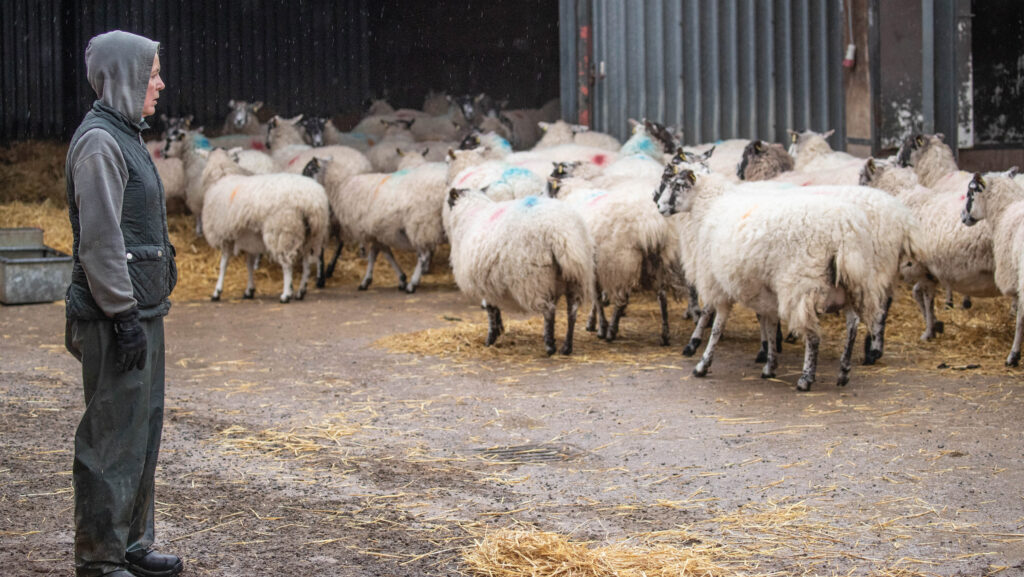Could thin ewes be a sign of infectious disease on your farm?
 © Tim Scrivener
© Tim Scrivener Farmers should not bury their heads in the sand when it comes to investigating infectious diseases within their flocks.
This was the message at the National Sheep Association Sheep Event, Malvern from sheep vet Phillipa Page from Flock Health, who encouraged farmers to investigate the cause of thin ewes.
“We all know thin ewes are costly, but what’s more costly is not investigating them and finding out why they are thin.
“We want to decide when ewes leave, not them, so it’s important to work out why they are leaving before they finish their job,” she said.
See also: How colostrum and new shed helped cut lamb mortality
Phillipa said body condition score (BCS) targets vary depending on the system, but regardless of breed, ewes should be no less than 1.5 BCS.
BCS targets
- Lowland ewe: 2.5
- Upland: 2
- Hill: 1.75
She said the rate and amount of weight loss are good indicators of iceberg diseases, so monitoring BCS and handling sheep during the main production points are key.
“We need to measure at weaning, pre-tupping, scanning and lambing, with an acceptance ewes will be their leanest at weaning and fattest at lambing.
“The egg starts developing six weeks after lambing, and the quality and amount of those eggs is dependent on the ewe’s condition. The challenge is keeping ewes at the right BCS at this key production point.”
She said there are multiple factors to rule out before testing for iceberg diseases, such as nutrition, tooth loss, trace element deficiencies, parasites and the biggest cause of weight loss – lameness.
Iceberg disease investigation
She said farmers should work closely with their vets to test for iceberg diseases and carry out post-mortems when the cause of death cannot be explained.
“Iceberg diseases limit production because they create a thin ewe. They tend to infect the animal when it is quite young, but we don’t see it until the sheep are older.
“They are chronic diseases caused by viruses or bacteria and spread from sheep to sheep or dam to offspring,” she explained.
These include the lymph abscess caseous lymphadenitis (CLA); borders disease, a virus that causes weak and hairy lambs; the respiratory viruses maedni visna and ovine pulmonary adenomatosis (OPA) and the bacterial infection Johne’s.
If infectious disease is detected within the flock, the first thing to do is not to panic, she assured farmers.
“We have buried our heads in the sand for a few decades; we actually have a problem now.”
Disease control
She said control is dependent on the system. Those with high-risk flying flocks may be best culling the “last ewes through the gate” or stragglers, as a way of dealing with disease.
However, medium-risk flocks that buy directly should ask buyers if they test for infectious diseases.
“If they say: ‘What’s that? I have never heard of it,’ I would stay away from the flock,” advised Phillipa, who said being aware of the flock’s disease status is better than being ignorant.
Low-risk, closed flocks must focus on protecting their health status.
She warned that if ewe lambs are grazed on dairy farms, this could pose a risk of Johne’s disease with the same strain responsible for infecting sheep and cattle.
She added farmers with active OPA problems should not use lick buckets until the disease is under control, as the virus spreads via aerosol transmission.
Why are thin ewes a problem?
- Thin ewes might be in oestrus for only a few hours
- At scanning, leaner ewes have less well-developed placentas, which results in smaller lambs
- At lambing time, lean ewes do not produce good-quality milk or colostrum and are more likely to get metabolic disease
- This also affects the maternal bond, which is critical in outdoor lambing flocks
- Lean ewes are more likely to get mastitis
- Thin ewes create challenges for shepherds – they must be grouped separately and fed a higher plane of nutrition, and they require additional labour at lambing (feeding lambs, for example)
